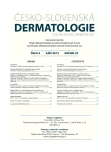Allergic Reaction to Contact with Toxicodendron radicans
Authors:
A. Kováčiková Curková; O. Žilínek; B. Benová; M. Šimaljaková
Authors place of work:
Dermatovenerologická klinika LF UK a UN Bratislava, Slovenská republika
prednostka kliniky prof. MUDr. Mária Šimaljaková, PhD.
Published in the journal:
Čes-slov Derm, 87, 2012, No. 4, p. 145-148
Category:
Kazuistiky
Summary
Toxicodendron radicans (“Poison ivy”) is a common poisonous plant. It is found, especially, in North America, including the maritime provinces of Canada. It grows well in areas in wet marshlands and river catchment areas. Poison ivy is well known for its production of an irritating substance, an oily resin called urushiol – a mixture of pentadecylcatechols. Urushiol is very sticky and easily attaches to the skin, clothing, tools, equipment or pet’s fur when touching the plant. Poison ivy contact dermatitis develops with itchy rash, blisters, reactions can progress to anaphylaxis. We report the case of a 27-year-old male with urushiol-induced contact dermatitis with impetiginization. He returned from Washington in The United States of America, where he did wild water kayaking. Authors want to highlight the role of dermatologists in detecting this unusual sensitizer occurring in imported cases in our countries.
Key words:
poison ivy – toxicodendron radicans – allergic contact dermatitis.
Zdroje
1. BALDWIN, R. W., CLEGG, J. A., CURRAN, A. C.: Regulation of the contact sensitivity response to urushiol with anti-urushiol monoclonal antibody ALG 991. Arch. Dermatol. Res., 1999, 291, p. 652–658.
2. EPSTEIN, W. L.: The poison ivy picker of Penny pack Park: the continuing saga of poisonivy. J. Incest. Dermatol., 1987, 88, 3, p. 711.
3. GLADMAN, A. C.: Toxicodendron Dermatitis: Poison Ivy, Oak and Sumac. Wilderness Environ. Med., 2006, 17, 2, p. 120–128.
4. http://www.aad.org/skin-conditions/dermatology-a-to-z/poison-ivy.
5. http://www.mayoclinic.com/health/poison-ivy/DS00774.
6. IVYS, T., TEPPER, R.: Failure of a tappe ring dose of oral methylprednisolone to treat reactions to poison ivy. JAMA, 1991, 266, 10, p. 1362.
7. JUCKETT, G.: Plantdermatitis – possible culprits go far beyond poison ivy. Postgrad. Med., 1996, 100, 3, p. 159–163.
8. KLIGMAN, A. M.: Cashewnut shell oil hyposenzitization against Rhusdermatitis. Arch. Dermatol., 1958, 78, p. 359–363.
9. LEE, N. P., ARRIOLA, E. R.: Poison ivy, oak, and sumac dermatitis. West. J. Med., 1999, 171, 5-6, p. 354–355.
10. PARISER, D. M., CEILLEY, R. I., LEFKOVITS, A. M., KATZ, B. E., PALLER, A. S.: Poisonivy, oak and sumac. Derm. Insights, 2003, 4, 1, p. 26–28.
11. WERCHNIAK, A. E., SCHWARZENBERGER, K.: Poison ivy: an under reported cause of erythema multiforme. J. Am. Acad. Dermatol., 2004, 51, p. 159–160.
12. WILLIFORD, P., SHERERTZ, E.: Poisonivy dermatitis. Arch. Intern. Med., 1994, 3, 2, p. 184–188.
13. ZHAI, H., MAIBACH, H. I., WILHELM, K. P.: Marzulli and Maibach’s Dermatotoxicology. 7th ed. CRC Press Taylor & Francis Group, Boca Raton, 2008, p. 205–206.
Štítky
Dermatologie Dětská dermatologieČlánek vyšel v časopise
Česko-slovenská dermatologie

2012 Číslo 4
- Diagnostický algoritmus při podezření na syndrom periodické horečky
- MUDr. Jaromír Zatloukal, Ph.D.: Dupilumab bude dalším milníkem v historii léčby CHOPN
- Proces hojení ran krok za krokem a co ho může zkomplikovat
Nejčtenější v tomto čísle
- Diferenciální diagnostika pruritu
-
Alergická reakcia na kontakt s rastlinou
Toxicodendron radicans - Subakutní kožní lupus erythematosus indukovaný spironolaktonem
- Lichen sclerosus et atrophicus anogenitalis u dětí: retrospektivní analýza souboru nemocných z období 2006–2010

